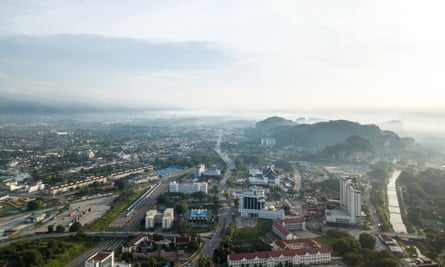Ipoh’s setting, among limestone hills in the Kinta valley, is magnificent. Whether you approach by road or rail, you’ll be wowed. There are furry-looking green trees clinging to the slopes, with pinkish granite rock in places where they’ve been washed away. It’s so pretty.
My earliest memories are of stars over Ipoh (it’s in Perak state). I remember running in the garden, feeling the warm air on my skin and seeing the pinpricks of light above. I was born in Singapore but we moved to Ipoh, where my mother is from, for a few years when I was a baby, and I lived there again for a while from when I was 12.

The Kinta valley was once the biggest producer of tin in the world. The pan handlers used to stand in the rivers and sift for it. My great-grandfather settled in Ipoh because of the tin rush – it was a place of opportunity in the late 1800s. My great-grandmother was of mixed Malay and Chinese heritage – we believe she was from southern Thailand and travelled by elephant to Penang, before moving to Ipoh with her husband.
The bean sprouts in Ipoh are the best in the world. Local lore says it’s because the limestone makes the water special. We have the fattest, crunchiest bean sprouts I’ve ever come across – nowhere in Malaysia, America or Europe has them as good.

In my first novel, Ipoh is almost a character itself: it has moods. On a clear, bright day, the limestone hills are almost blue in the haze, but when it’s cloudy – which only lasts a few hours until the sun bursts through – they become quite dark, with floating mist at the top. I love the moodiness of the landscape – it’s like a painting – and I love the breeziness the hills bring.
The old town of Ipoh is easy to walk around. There’s what we call a “five-foot way” in front of the rows of shophouses, a corridor shaded from the heat. A Lithuanian artist has painted murals depicting scenes of Malaysian life on the walls, windows and shutters, which makes it quite distinctive.

Of all Ipoh’s night markets, or pasar malam, the biggest is in First Garden on Fridays. I love the bustle, the great food and unusual things to eat, like fried ice-cream. It’s so noisy some vendors wire themselves up to a mic and stand there shouting at shoppers.
Malaysians eat out a lot as it’s quite cheap. Try Lou Wong coffee shop for “chicken bean sprouts” with rice or rice noodles: that’s literally all they sell, from lunch until around midnight, and it’s generally packed.

The name Ipoh comes from a poisonous tree. Its resin was used by indigenous people in darts for hunting. The ipoh tree was the subject of a 1828 poem by Alexander Pushkin called The Upas Tree.
To get away from crowds, go to Kledang Hill. It’s a steep 800-metre hike to the top and takes around three hours, so do it in the cool of the morning. You probably won’t pass anyone and the view is spectacular.

Comments (…)
Sign in or create your Guardian account to join the discussion